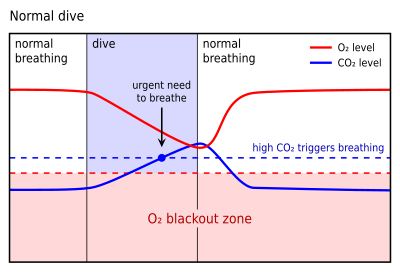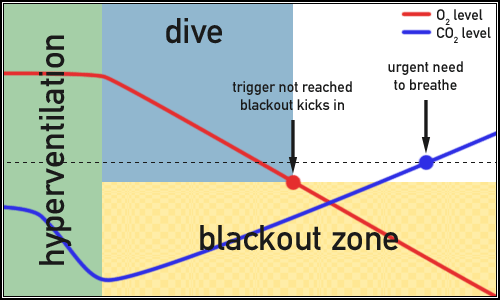Shallow water blackout
From a pool blackout one speaks at a sudden loss of consciousness under water during apnea diving (diving without breathing apparatus ).
Notes
The respiratory stimulus is triggered by rising carbon dioxide partial pressure in arterial blood in the normal state. During an interruption of breathing, for example during the dive, the carbon dioxide content in the blood increases and respiratory irritation is getting stronger. If the carbon dioxide partial pressure of a certain value, then a breath is done (even if unconscious ). A while reducing the partial pressure of oxygen in the blood causes a loss of consciousness.
Through training you can suppress this stimulus, which can be forced to breath but only to delay and not work off. If the carbon dioxide content in the blood is reduced dramatically through increased, conscious breathing before the dive ( hyperventilation), the strength of the respiratory stimulus increases correspondingly slower. The forced breath may be delayed up to several minutes. However, the oxygen content is increased only marginally in the blood by the hyperventilation before diving.
During the dive is now increasing the carbon dioxide content ( CO2) wherein the oxygen content (O2) continuously decreases by consumption. Since the freediver is not breathing, CO2 partial pressure increases in arterial blood - from a normal value of about 53 mbar - continuously until from about 80 mbar. From this value of the respiratory stimulus is so strong that you ( long ) appears in front of unconsciousness and conscious breathing. Due to the hyperventilation of the CO2 partial pressure in arterial blood can be reduced to 20 mbar, so the onset of the respiratory stimulus is greatly delayed. Falls below the oxygen Partialduck in arterial blood at the same time the threshold of about 40 mbar, as occurs due to a lack of oxygen in the neural tissues ( nervous system) an unconscious one, without any warning.
If the unconsciousness occurred while the head was in the water, this breathing stimulus leads so forcibly to one breath under water and thus perhaps to inhalation of water ( aspiration). In the brief period between the entry into unconsciousness and respiratory irritant, the diver should be brought to the surface so that it does not come to aspiration of water.
The term pool blackout can be explained by the fact that many divers in the water park hyperventilate before a diving attempt (due to the assumption by rapid, shallow breathing get more oxygen into the blood ) and thus do not show up on time for lack of intensive respiratory irritant. The diver will suddenly collapse under water and is therefore also the risk of aspiration exposed.
Rise Blackout
A special form of the swimming pool blackout is occurring principally in No - Limits Apnea diving ascent blackout. The term "no- limits " means that part with technical aids - is an attempt to achieve the greatest possible depth - but without breathing apparatus.
Due to the increased ambient pressure, the partial pressure of O2 in the blood takes when diving too strong. It is solved using supplemental oxygen in the blood. Diving apnea divers back to one, the relationship to the contrary. The O2 partial pressure decreases, so it can lead to a lack of oxygen in neural tissues ( nervous system). This defect causes a loss of consciousness without any warning. This is because the diver during the dive consumes oxygen and simultaneously increases the partial pressure of CO2 in the blood.
The ascent blackout can occur regardless of the depth at the appearance, which is why it is no longer called shallow-water fainting.










